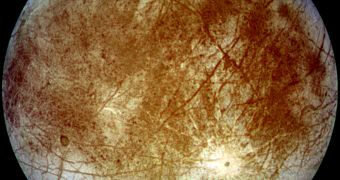According to new computer models developed by researchers at the University of Texas at Austin (UTA), it would appear that Europa, one of Jupiter's most interesting icy moons, may feature on ocean of liquid water under the thick ice sheet covering its surface.
The data also indicate that the water is relatively warm, after being heated by the moon's core and a series of convection currents that churn it continuously. If true, it may be possible for simple lifeforms to emerge and develop in this secluded environment, the study team argues.
A churning ocean is one of the most elegant (and promising) ways to explain the outwardly appearance of Europa, which is criss-crossed by ridges and cracks all around its equator. If a massive body of liquid water lies underneath the surface, then its motions could explain these landscape features.
Currently, geologists estimate the Europa has an icy surface about 15 to 25 kilometers (10 to 15 miles) deep, roughly half the thickness of Earth's oceanic crust. However, the Jovian moon is roughly the same size as our planet's natural satellite, meaning that there is ample room under its crust for water.
Some models suggest that the ocean on Europa – long hypothesized to exist, but never actually detected – could be around 160 kilometers (100 miles) deep. Its motions could explain why 40 percent of the moon's surface is jumbled up, warped and broken, particularly around the equator.
The model developed by UTA planetary geophysicist Krista Soderlund and her team departs from the standard understanding of potential two-dimensional water flows under Europa's ices, and assumes that these flows and currents occur in three dimensions.
If that is indeed the case, then the churning ocean under the surface would have produced massive turbulences and heat flows at low latitudes, forcing the crust to become damaged along the equator.
“One way to think about this is to consider the classic example of a boiling pot of water. If the pot is much larger than the burner, water will convect more vigorously at the center than near the edges,” the team leader explains, quoted by Space.
While the model provides an explanation for so-called chaos terrain on Europa, its main advantage lies with proposing significant implication for the small world's habitability potential. “The currents would enhance the transport of nutrients from the seafloor to the ice shell, especially at low latitudes,” Soderlund says, increasing the chances of life enduring at these locations.
Details of the new model appear in the December 1 issue of the top journal Nature Geoscience. The team says that missions such as the NASA Europa Clipper and the European Space Agency's (ESA) JUICE probe could potentially shed more light on the Jovian moon's internal composition.

 14 DAY TRIAL //
14 DAY TRIAL //